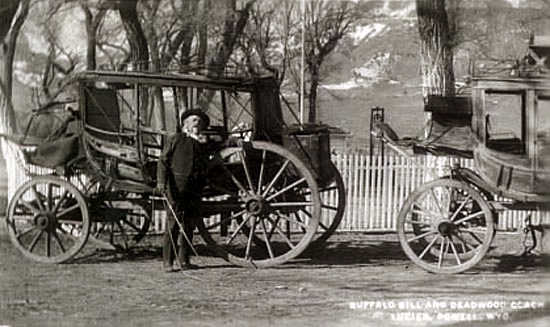
Col. Wm. F. Cody, next to Deadwood Stage parked at Cody's TE ranch, photo by A. G. Lucier. See text below.
The attack upon the Deadwood Stage was a centerpiece
of Wm. F. Cody's Wild West Show, photo of Cody next to Deadwood Stage,
above. The coach depicted was constructed by the Abbot-Downing Co., Concord,
N.H. in 1863 and was shipped to the Pioneer Stage Co., San Francisco, around Cape
Horn on the clipper ship General Grant. The coach was taken by Cody to Europe twice
where it was billed as the "Most Famous Vehicle Extant." Among those given
rides in the coach on its European tours was the Prince of Wales, later Edward VII.
The coach was purchased by Col. Cody in 1911 and is now on exhibit at the Buffalo Bill Museum in Cody. See next photo.
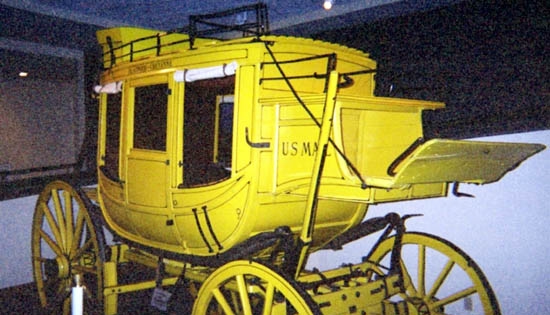
Deadwood Stage, Buffalo Bill Museum, Cody, 2003, photo
by Geoff Dobson
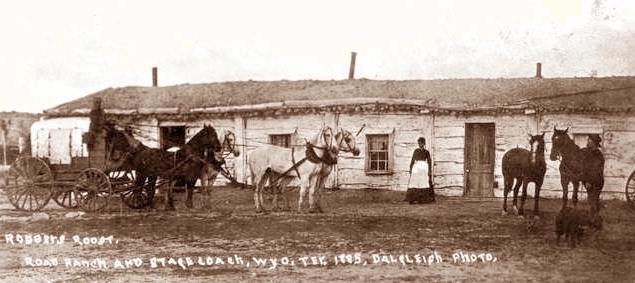
Robbers Roost Station, photo by Thomas Dalgleish, 1885.
Robbers Roost Station was about three miles north of
present day Mule Creek Junction. Thomas Dalgleish, brother of Colorado photographer George
Dalgleish, maintained a studio in Buffalo, Wyoming. For another view of a Deadwood stage, see view of
stage parked next to the Lusk Museum on subsequent page. The stage line initially ran from Cheyenne via Horse Creek,
Bear Springs, Chugwater, Chug Springs, Eagle's Nest, and Fort Laramie where the stage crossed the newly-opened
Military Bridge. At Hat Creek Station, north of present day Lusk, the stage road split, one branch continung
due north past aptly named Robbers Roost following the approximate line of present-day
U. S. Highway 85 into Deadwood. The other branch turned eastward at Hat Creek Station and followed
Spring Creek, turning northward to Custer City. The latter route was so dangerous that it
was shortly abandoned in favor of a more easterly route through Buffalo Gap and coming into the
eastern Black Hills. Indeed, one early correspondent for the New York Times described the
Indian Creek road as as "perfectly lined with rifle-pits, and occasional grave thrown in
to make one cheerful." The Indian Creek Station was a fortified dugout with rifle ports from which
its occupants could perforate Indians who came within range. The corral also was a dugout, allegedly to
protect the horses from marauding Indians. The road through Indian Creek Canyon in wet weather was
thick gumbo. One writer described his journey down Indian Creek:
[A]fter passing through a number of deep and miry water-courses, our teams swung around under the
shadow of a gread overhanging bluff of yellow earth, and we found ourselves upon the banks of Indian
Creek, which, our driver announced, was the most dangerous part of the whole journey.
The bed of the creek is about two hundred yards in width, and the banks are steep and high. Sharply outlined mounds of earth rise at
frequent intervals in the stream-bed, and form places of protection from which the
murderous savages may fire upon their unsuspecting victims, without any risk of being killed or wounded
them selves; moreover, the course of the creek is heavily timbered, so that it is almost impossible to distinquish forms
a short distance away.
* * * *
When the ground impregnated with alkali is damp or wet, it forms the most villainous clinging compound
imaginable. The revolving wheels quickly became sold masses of heavy mire, the spaces between the spokes and between the
wheel and the wagon-box being completely filled, so that every hundred yards or so
it beame necessary to dismount and pry it away with a crow-bar. In order to relieve the jaded
horses, the greater number of the passengers dismounted. But after half a dozen steps their boots would pick up great slabs
of the earth, and they too were forced to resort to the crow-bar.
Magazine writer Laura Winthrop Johnson, "Eight Hundred Miles in an Ambulance," Lippincott's Magazine of Popular Literature and Science, June 1875,
described the road northward from Cheyenne as:
over a succession of small creeks and divides. These table-lands were always
barren, and covered with the same thin gray vegetation, but sometimes
adorned with a few flowers—the beautiful agemone or prickly poppy, with its
blue-green leaves, large white petals and crown of golden stamens;
the pretty fragrant abronia, and the white oenothera. A deep pink
convolvulus was common, which grew upon a bush, not on a vine, and was a
large and thrifty plant. Sage and wormwood were seen everywhere, and on the
streams we found larkspur, aconite, little white daisies and lungwort,
lupines and the ever-present sunflower. But usually all was barren—barren
hills, barren valleys, barren plains. Sometimes we came upon tracts of
buffalo-grass, a thin, low, wiry grass that grows in small tufts, and does
not look as if there were any nourishment in it, but is said to be more
fattening than corn. Our animals ate it with avidity. Was not all this
dreary waste wearily monotonous and tame? Monotonous, yes; but no more tame
than the sea is tame. We sailed along day after day over the land-waves as
on a voyage. To ride over those lonely divides in the fresh
morning air made us feel as if we had breakfasted on flying-fish. We felt
what Shelley sings of the power of "all waste and solitary places;" we felt
their boundlessness, their freedom, their wild flavor; we were penetrated
with their solemn beauty. Here the eyesight is clearer, the mind is
brighter, the observation is quickened: every animal, insect and bird makes
its distinct impression, every object its mark. There is something on the
Plains that cannot be found elsewhere—something which can be felt better
than described—something you must go there to find.
Other travellers on the stage road complained of the monotony of the journey. Mrs.
Annie D. Tallent later wrote that the "opprobrium" of disgusting monontony was releved
"only be the superabundance of mud encountered at intervals, claiming our undivided attention." The Last
Hunting Ground of the Dakotahs, Nixon Jones Printing Co., St. Louis, 1899.
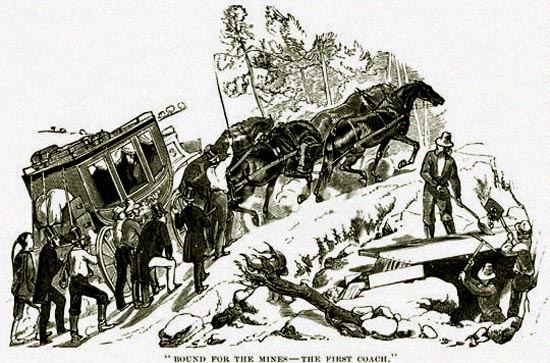
"Bound for the Mines, First Coach" Woodcut, Strahorn, Robert: Handbook of Wyoming, 1877.
In the Summer of 1876, unsuccessful several attempts
were made to reach Deadwood by stage from Cheyenne
but turned back due to the danger of marauding Indians following their
defeat of Custer at
the Little Big Horn.
Prior to mail being carried by stage, mail was carried by a private
mail service organized by Charlie Utter. Messages would be telegraphed from Cheyenne to Fort
Laramie, transcribed, and carried by express riders to Deadwood. To avoid the Indians, the messengers would
ride primarily at night. In this manner, messages could reach Deadwood from Cheyenne in only 48 hours. During its
three months of operation, Utter's service never lost any mail to the Indians although there may
have been a few harrowing moments.
The most dangerous part of the journey, however, was the night run near the
Hat Creek Station, north of Lusk. There, Big Nose George, see Rawlins, committed many of his
depredations.
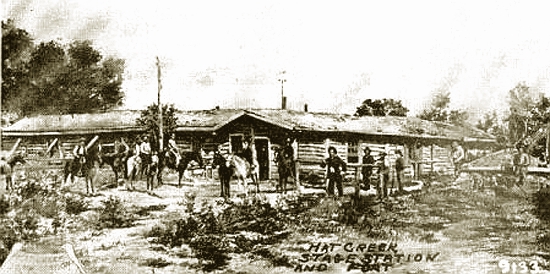
"Old" Hat Creek Station, approx. 1880.
The Old Hat Creek Station and Fort, established in 1875 by Capt. James Egan, was located north of the Hat Creek
Breaks on Sage Creek. Capt. Egan mistakenly believed he was on Hat Creek in Nebraska. Egan, an
Irishman, received a battlefield commission in the 2nd Cavalry during the Civil War, was wounded at Cold Harbor, and saw service in
the west from the end of 1865 until at least the late 1870's, being stationed at various times at
Ft. Lyon, Colo., Ft. Sanders, Ft. D. A. Russell, Ft. Laramie, and in Montana.
The fort burned in 1883. Subsequently a new
station was constructed a short distance to the west on Cottonwood Creek. The "new" station, still in
existence, was a log, two-story, hip-roofed structure.
Stations frequently would have all needed accommodations for
travelers, including corrals, blacksmiths, feed for the horses, etc. The larger, more elaborate stations were
referred to as "road ranches". The modern equivalent would be a truck stop with a motel. The
Ecoffey and Cuny facility, discussed on a subsequent page, started out as a road ranch, but was converted
to a hog ranch when there was a decline in business.
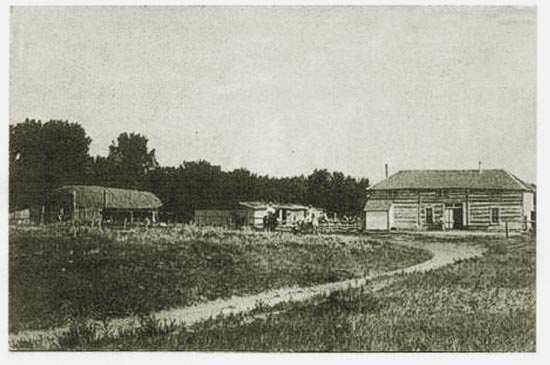
The "New" Hat Creek Station, 1909
About eight miles north the Hat Creek Stockade, Indians shot the a horse beneath one messenger, Brant Street.
Another ball struck the pommel of Street's saddle and a third
knocked the heel from his boot. Street took cover in an arroyo. There he and the Indians
exhanged fire until with darkness the Indians withdrew. Street then crawled out to his
dead horse, retrieved the mail pouches and carried them on his back to the stockade. On Sept. 25, however, Dave Dickey brought the first stage
into Deadwood. But certainly the danger from Indians remained. Indian attacks on
the stage stations were not unexpected and the corrals took the form of fortified stockades so
as to preclude theft of the horses. In one instance, "Indians" attacked a station and after
the horses were stolen, it was discovered that the "Indians" had opened the padlock on the corral with a duplicate key.
Division superintendent H. E. "Stuttering" Brown was killed ostensibly by Indians near
Old Woman's Branch of the Cheyenne. Stuttering Brown had previously been a freighter, ran a
road ranch west of Scott's Bluff, and a gambling den in Omaha.
There were those, however, who suspected that Brown's
murder was committed by William "Persimmon Bill" Chambers. Persimmon Bill was a reputed horse thief and
murderer who kept a shack near Cheyenne Crossing. He and Stuttering Brown had a
mutual dislike for each other and, thus, Persimmon Bill was suspected of the killing. Persimmon Bill was allegedly an associate with the
notorious horse thief Henry "Dutch Henry" Born (1849-1921). Persimmon Bill was also
suspected of complicity in the 1876 stealing of some $10,000.00 worth of
Kentucky Whistkey being shipped to Deadwood by Charles Sasse & Company. Sasse's wagon train of
25 wagons and 100 mules loaded with the whiskey had camped in Red Canyon. During the night all of the
mules were run-off leaving the wagon train stranded and subject to the larceny of the cargo.
Periodically thereafter, the Kentucky whiskey would show up in Deadwood. Persimmon Bill's fate is subject to debate.
According to Patricia Jahns, The Frontier World of Doc Holliday: Faro Dealer from Dallas to Deadwood,
he was killed by Boone May. May is discussed on a subsequent page. According to Dan Thrapp, Persimmon Bill was hanged in
Tennessee. Dutch Henry, originally from Wisconsin, received his name as a result of his
German accent recieved from his German immigrant
parents. According to Charles Kelly, The Outlaw Trail, Dutch
Henry was killed by a partner in crime, Ben Tasker from Centerville, Utah. Dutch Henry's body was burned by
Tasker at Desert Spring, Utah. The remains were identified by his derringer found in the ashes. In actuality,
however, Dutch Henry met up with Hanging Judge Parker and was sentenced to twenty years in the
Arkansas Penitentiary. When he got out, he prospected for gold near Creede Colorado with a partner. His
partner froze to death. Dutch Henry returned to Wisconsin, married, and with his bride returned to
Pagosa Springs, Colorado, where he lived out the remainder of his life.
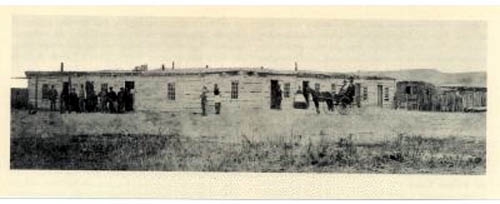
Brown's Hotel, Ft. Laramie, 1868. Photo by
Alexander Gardner (attributed). Note sod roof.
With the opening of the line, a new hotel was constructed at Fort Laramie for the passengers, the Rustic Hotel. On
the north side of the newly opened Military Bridge was the older log and sod Brown's Hotel operated by
William H. Brown. At first, the Rustic Hotel was regarded as a first class
operation with fine linens and dining room. Soon, however, complaints were
received from guests about a problem, bedbugs. The problem grew to such a
point that the fort's commander had to take matters into his own hands and
ordered the hotel to be fumigated. Another difficulty also arose. The hotel's corral
polluted the fort's water supply. From Ft. Laramie the stage road proceeded northward
though Indian and outlaw territory to Rawhide Buttes and Hat Creek north of Lusk (pictured on next page). At the Cheyenne
River, the road split. One branch continued north past Robbers Roost Creek, Jenny's Stockade and along Beaver Creek and on
in to Deadwood. The other branch followed the Cheyenne into Dakota Territory and up to
Custer City, Gayville and into Deadwood.
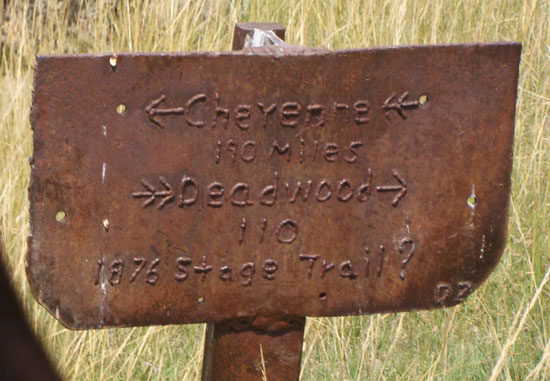
Sign along old Deadwood Stage Road near Edgemont, South Dakota. Photo courtesy of Bob Vance.
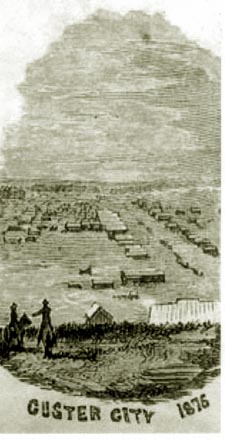 Custer City, 1876, from Strahorn's Handbook of Wyoming
Custer City, 1876, from Strahorn's Handbook of Wyoming
Prior to
the coming of the stage line, other than the hotel at Ft. Laramie, the traveler northward of Cheyenne found few if any
places of public accommodation, no road ranches, no taverns. Mrs. Johnson in her account of her 1874 trek northward to visit
the Indian agencies, describes having to camp at night. Along the way, she writes of the
nightly ritual of picking the burrs out of one's clothes, the evening repasts being blown away by whirlwinds coming off
Rawhide Buttes, and in the evening, as "a blood-red sunset flames from the horizon to the upper sky: and as it darkens,
and the wolves begin to howl, we think of * * * all the wild stories we have heard of
robbers and fights and Indian massacres."
Opening the line required the construction of swing stations and home stations to
service the stages and their passengers. As indicated by the photos on subsequent pages, most were crude
affairs constructed of logs and sod.The station at Running Water, as an example, was a soddie.
Advertisements for road ranches along the road may have raised a traveler's expections. Jack
Bowman's Hat Creek Station claimed in one ad that the table was "supplied with the best of everything."
John Phillips's "Regular Eating Station for Stage Passengers" claimed that it featured the
"Best of Board." In actuality, food at road ranches typically consisted of either beans and beef served separately or
beans and beef served together from communal platters "boarding house style." That, of course,
led to boarding house reach, and one better be quick about it or go hungry. The dinnerware, according to
one passenger, consisted of chipped blue enamelware which was usually greasy. The conditions led to the old joke about the passenger
who complained about the cleanliness of the towel and was told, "Twenty-six men used it before and
you're the first one that complained.
Phillips' "best of board" may have had a slightly different meaning. He provided accommodations. Beds in
road ranches providing overnight accommodations were frequently furnished with "beds" which consisted of
a platform equipped with boards upon which reposed a straw mattress. Men would frequently sleep on the floor using
their carpet bag as a pillow. Blankets in most instances were never washed.
Edward Gillette, after whom Gillette, Wyoming, is named, noted that the "hotels" also were not well heated. He wrote:
Travelers stopping at these flimsy places used to
make a grab for their clothes in the morning and rush to the
office, where there would be a big box stove with a roaring fire to
keep a man from freezing. One very cold morning a farmer came into the office
with icicles dangling from his whiskers, and a salesman who had
spent the night in the hotel asked him, "Which room did you have?"
Sir Samuel Baker in Wild Beasts and Their Ways, Macmillan, London, 1890, commented as to
a different discomfort in one road ranch on the Rock River to Fort Custer line, the vermin;
When the lamp was extinguished, the bed was alive. I always marvelled at the phrase,
"he took up his bed and walked," but if the bugs had been unanimous,
they could have walked off with the bed without a miracle.
Sleeping was impossible. I relighted the paraffin lamp, a retreat was evidently
sounded, and the enemy retired. Presently an explosion took place—the lamp had gone wrong,
and burst, fortunately without setting the place on fire. An advance was sounded,
and the enemy came on, determined upon victory.
I never slept in one of those prairie stations again, but we preferred a camp sheet
and good blankets on the sage-bush, with the sky for a ceiling.
And even at the end of the journey, the hotel accommodations in Deadwood City might be regarded
as less than first class. Ranchman Edgar Beecher Bronson in his 1906 Reminiscenses of a Ranchman after two days on
the stage checked into the Grand Central Hotel in Deadwood City but could not sleep for the
sounds of the rats in the walls. He threw a boot at the wall. To his embarrassment, the boot
went right through the wall made of cotton sheeting and paper and hit the guest in the next room.
Passengers were left to their own to relieve the boredom. On Bronson's journey, his fellow passenger was
"comfortably drunk." Part of the journey was on the sabbath. Therefore, the two amused themselves with
the singing of hymns. The coach proceeded northward to the sounds of the two singing "Shall we gather at
the River," "A Charge to Keep I have," and "From Greenland's Icy Mountain." Bronson's fellow passenger continued
to imbibe. Finally, the two sang the old hymn "I Hunger and I Thirst." The fellow passenger passed out as they came to the words,
"Thou true life-giving Vine,
Let me Thy sweetness prove."
Deadwood Stage continued on next page.
|